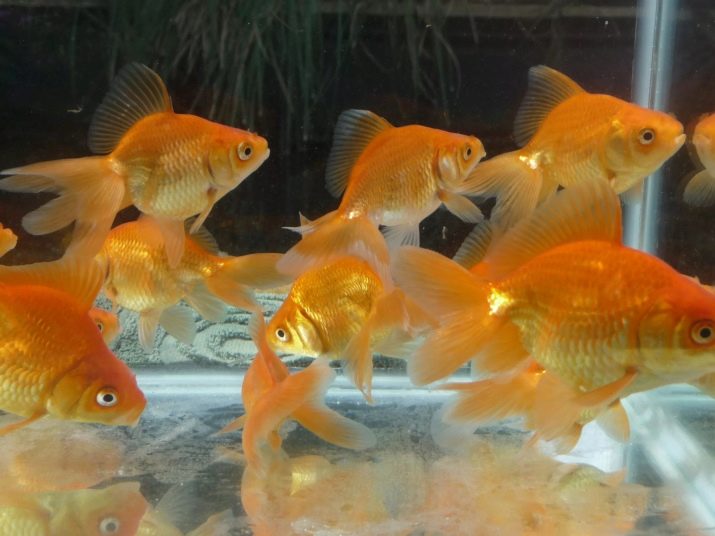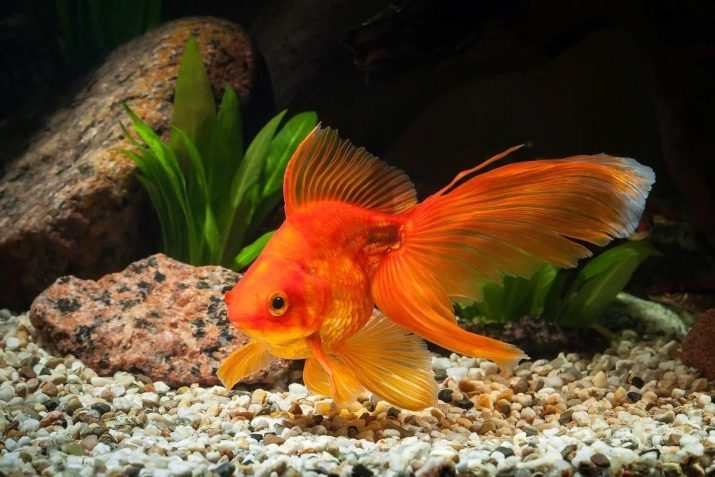Keeping and caring for goldfish

Keeping goldfish and caring for them, due to the popularity of the breed, seems to be a completely simple matter even for a novice aquarist. With the light hand of storytellers, these pets are often purchased for children. But an adult has to take care of a new family member.

The main thing is to keep aquarium fish at home so that they feel comfortable. The choice of food is also important, and some other points that affect the state of the aquatic environment. Considering all these points, you can take good care of your pet, and learn a lot about the peculiarities of his life.

Choosing an aquarium
First of all, you need to think about the formation of a comfortable environment, because the goldfish is very sensitive to the quality and purity of water. Moreover, and the aquarium itself must fit its inhabitant.
The first thing to start with keeping goldfish is preparing your aquarium.
Mini versions are only suitable for young animals or as a quarantine... Adults grow up to 15 cm; in large bodies of water, the length of its body without a tail reaches 40 cm.Accordingly, a small aquarium can hardly be called the right choice. Not suitable for keeping cylindrical containers or screens.

When choosing a tank for keeping goldfish, you need to be guided by the needs of your pets. For a couple, a volume of at least 100 liters is required; when replanting the following inhabitants, another 40 liters will be needed per individual. Optimal shape for an aquarium - parallelepiped, its length must be twice the height and width (they are equal).
Curved glass tanks create a stressful environment for the occupants.
It is very important to remember that most of today's goldfish come from the countries of Southeast Asia., from places with open content. Whereas in Soviet times, aquarists dealt exclusively with pets cultivated in an artificial environment for many years. Modern individuals require much more space for swimming. You should only trust the latest information, otherwise fish may die within 1 week after purchase.

Growing conditions for different species
Goldfish should be looked after according to their basic needs. Despite the fact that they are recommended for beginners, these magnificent representatives of the underwater world have their own peculiarities of aquarium maintenance.
It is necessary to take care of each representative of different subspecies in its own way.
There are exclusively domestic goldfish, for which the temperature of the environment and its other characteristics are important. Consider how to properly contain each of the species, and who can survive even outdoors.

It is worth considering the features of growing different goldfish in more detail. Among the available types, several options can be noted.
Common goldfish
The most unpretentious in the content. She can live in open reservoirs in summer; in warm climates, outdoor maintenance is completely permissible. Indoor specimens are much smaller - about 15-20 cm in length.

Veiltail
One of the most leisurely varieties. Poorly tolerates neighborhood with more active individuals. The veil tail has long fishnet fins, large eyes, and needs no traumatic elements in the interior of the aquarium.
To feel comfortable, you need cool water and good aeration.

Telescope
A characteristic feature of these fish is very large eyes. When choosing decorations, it is important to give preference to those that do not injure the protruding parts of the pet's body. With severe hypothermia, the fish may die.

Jikin butterfly
A type of goldfish suitable exclusively for aquarium keeping.

Bubble eye
Fish with bags around the eyes, accounting for up to 25% of the total body volume. There is liquid inside, so there should be no traumatic elements in an aquarium with such a pet.
Bubbles burst easily, caring for the fish implies the utmost care, the absence of stones, plants with sharp parts within reach.

Pecilia
Goldfish with a diamond-shaped body, small head, wide fin. Suitable for both aquarium and open-air environments.

Oranda
Fish with a golden-red bright "cap" and a white-pink, black, chocolate or variegated body. For oranda, a large volume of water is important for swimming, it is much more needed than beautiful scenery or an abundance of plants.
Unfavorable conditions of detention can lead to the fact that the bright "cap" simply disappears.
Needs bright lighting.

Ranchu
A subspecies without a dorsal fin, with a flattened body. The best option for keeping is home, in a species aquarium.

Ryukin
A fish with a characteristic arched back, very slow, sensitive to temperature parameters, does not tolerate cold well.

All types of goldfish are focused on keeping in spacious open or artificial reservoirs. The optimum temperature is within +20.25 degrees Celsius. The pH should be 6.9-7.2. Water hardness - from 8 units. Among the goldfish there are cold-blooded individuals - these include the telescope and some other long-bodied subspecies.

Decorative species - bubble-eyes, veil-tails, dzikin butterflies, oranda prefer the most warm water. A drop in temperature can be fatal for them.

How and what to feed?
Feeding your goldfish involves eating a balanced, fairly nutritious diet. Dry pellets and flakes are given alternately with plant-based feeds. Among green foods, salad or spinach is the best solution. It is permissible to give boiled cereals, vegetables, pamper pets with oranges, kiwi, carefully chopped.

From animal food, frozen bloodworms, pieces of meat, and liver are suitable for goldfish. Frozen feed is pre-thawed. It is useful to periodically offer daphnia to fish. Every week, for the prevention of diseases, a fasting day is arranged for pets. Plants in the aquarium - riccia, wolfia - can also act as top dressing.
It is important to consider: goldfish should receive as much food as they can eat in 3-5 minutes.
Due to their tendency to overeat, they should not be too pampered. 1-2 feedings during the day will be enough for them. Excess food is removed mechanically to avoid contamination of the water.

Content Issues
Beginner aquarists face some difficulties when keeping goldfish. First of all, it becomes a mistake to preserve a temporary reservoir as a pet's place of residence. It can be a beautiful glass on a high stem, a compact aquarium, or a regular jar.
The sooner the pet is in quarantine conditions and adapts to the proposed conditions, the better it will feel.
Buying a small aquarium, especially for a few goldfish, will also pose major challenges.

Content errors
The minimum volume of the tank is 50 liters per individual. Accordingly, the couple will need a container of 100 liters. Another important point is the size of the soil fractions. Goldfish have a habit of digging in bottom contents and can choke on small stones 3-5 mm in diameter. It is better to choose a coarse-grained filler from the very beginning.
The sensitivity to the cleanliness of the aquarium in goldfish is quite high, while they rather intensively reproduce or dirt due to their physiology. Following the misconceptions about "self-cleaning" of the environment, you can create unacceptable conditions for the habitation of pets.
For fish, you need to install a complete filtration system using internal and external devices. Purifiers must work around the clock.


Goldfish require a fairly high oxygen content in their water. It is unlikely that it will be possible to achieve optimal performance in a natural way. It will be much more effective to use a compressor for these purposes, which additionally creates the necessary indicators of the environment in the aquarium.
Another difficulty in keeping goldfish is their indomitable passion for exterminating greenery.
But this should not become a reason for refusing to plant herbaceous plants. They have a beneficial effect on the functioning of the digestive system of fish and help fight algae. To preserve the created ecosystem, it will be enough to distinguish between the "grazing" of pets and plants for decorating the aquarium. Lemongrass, Anubias, Cryptocoryne will do.

Frequency of water changes is another mistake the novice aquarist can make.
Faced with the gluttony of pets and the abundance of waste from their vital activity, the owners of the goldfish try to withstand the weekly schedule of substitutions. But these inhabitants of freshwater bodies need more frequent water changes. The best option would be to replace about 30% of the environment twice a week. It is worth considering that the change in the regime of substitutions should be smooth and gradual, otherwise the fish may experience serious stress and get sick.

Overfeeding or underfeeding
The goldfish is a bright representative of its family, greedy for any food. Moreover, these bright beauties very diligently beg for food, and it is quite difficult for a novice breeder to refuse them. But here only one rule should apply: a hungry fish is always healthy. The volume of the diet is measured taking into account the daily rate, divided into 1 or 2 meals.
When overfeeding, pets get sick, they can die. No more food is given at a time than one or more fish can eat in 5-10 minutes.

Compatibility
The desire to add neighbors to the aquarium with goldfish looks quite justified - it is difficult to imagine a beautiful aquarium as a monobreed one. But such experiments are rarely successful. Larger individuals, and even guppies, can attack and eat goldfish. Especially often in the risk group is the veiled variety. Attempts to hook up smaller neighbors end up ending their lives in the stomach of a goldfish.
Catfish, indifferent to everything, are a rare exception, and they can simultaneously fulfill the role of aquarium orderlies. It is better to protect representatives of other decorative breeds from such a neighborhood.
If everything is done correctly, the goldfish can easily live for more than a dozen years and will delight the owner with vigor and well-being.

In the next video, you will learn how the male goldfish differs from the female, and how the courtship process of fish occurs during the breeding season.








